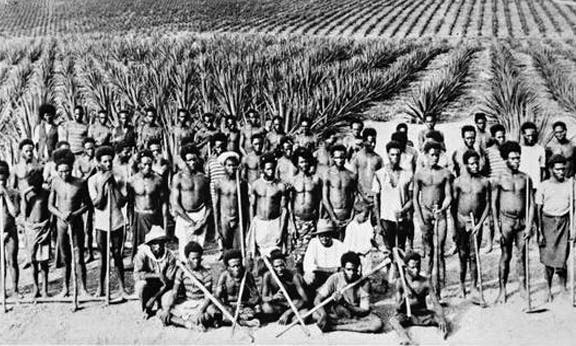Owning up to Australia’s slave labour past

This year marks the 170th anniversary of the beginning of “blackbirding”, the kidnapping of people from Pacific islands and bringing them to the Australian colonies as indentured labour.
In 1847, “pioneer” Benjamin Boyd, in an effort to maintain a failing pastoral and whaling business, kidnapped 119 Melanesian men to work as slaves in Eden on the New South Wales coast. This year, the committee of Australian South Sea Islanders-Port Jackson (ASSI-PJ) commemorated the anniversary with a conference, held on 8 September, to bring these stories to light.
Emelda Davis, president of ASSI-PJ, told Red Flag that Boyd’s entrepreneurial experiment was “a human disaster”. It was also a stark illustration of how Australian capitalism was built: first on the bodies of the Indigenous people who were an impediment to profit, and then, as Davis put it in interview with Matt Wordsworth on Radio National Breakfast, “on the backs of Blacks … and those other nationalities that came in as part of indentured labour” and lived here in servitude.
The South Sea Islanders enslaved by Boyd made several attempts to escape. Finally leaving Eden on foot as refugees, and vilified by the rabidly racist press, they walked all the way to Sydney seeking passage back to their lands. A man named Tanna tragically drowned in Sydney Harbour right near Boyd’s estate. None of the group made it back to their home.
This episode pre-empted the official start of the Australian slave trade some years later. On 14 August 1863, people were lured onto ships from the beaches of Vanuatu. Between then and 1901, some 62,500 people were captured from 80 different islands. Some places had their entire male population taken away.
It is thought that up to one in four died either on the journey or while working in the atrocious conditions on ships, or more commonly among sugar cane in Queensland. Some died from common colds, which their immune system couldn’t handle, others from malnutrition from the “stodgy flour-like food” they were served, or from working from dawn until sundown, which broke them physically. Davis said that some died from “broken hearts” due to intense feelings of dislocation.
With 30 percent of kidnapped South Sea Islanders dead within the first year of blackbirding, the colonial administrations knew full well the horrors, but continued the practice regardless. If the establishment of profitable industry in Australia came at the cost of lives, the ruling graziers, cane barons and administrators said, “So be it”.
After the White Australia policy was introduced in 1901, 7,000 South Sea Islanders were deported to random islands. Davis’ grandfather escaped these deportations on foot from Mackay to Sydney.
“Australia needs to know the truthful beginnings of the nation”, Davis said. Recognition of these stories, even though they contradict the national mythology, is the first step. However, the issue of compensation for unpaid wages ($40 million in today’s money) and reparations is one that the government is unwilling to broach.
Furthermore, it’s still the case that monuments to the genocidal practice of blackbirding remain. Townsville is named after wealthy blackbirder Robert Towns. Benjamin Boyd has a national park to his name.
Commenting on the worldwide movement to tear down racist monuments, Matt Wordsworth asked Emelda Davis her response to the right’s catchcry, “Where do we draw the line?” Davis responded, “The line gets drawn at telling the truth”.